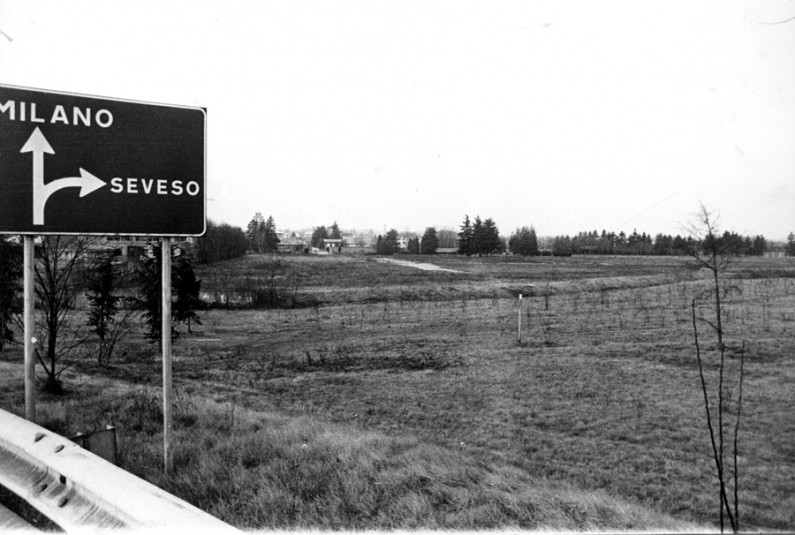
On Sunday, 11 July 1976 in the afternoon the Mayor of Seveso, Francesco Rocca, received the visit of two ICMESA technicians who reported to him about an accident that happened the day before inside the factory.
“They were brief in describing the incident – the Mayor recalled – and gave a rather technical description of it. It was the first time I had ever heard about “tetrachlorophenol or TCP.”
«It is a basic intermediate chemical,» Dr. Paoletti immediately explained. «You can also find it at the drugstore, and it serves also as a herbicide. And precisely the reactor that produces this exploded. Nobody really knows why. Yesterday morning at six, the shift ended and as on every Saturday, they had let the reactor cool down. Tomorrow the production of TCP would have resumed as usual if it wasn’t for this uncontrollable reaction inside, which slowly caused the temperature and pressure to rise, until it exploded around midday.»
More
On 12 July 1976 Dr. Uberti, substitute health officer standing in for the appointed officer, Professor Ghetti, then on holiday, received a letter from the directors of the factory stating: “In relation to the previous information and interviews and your visit today, we confirm as follows:
On Saturday 10 July 76 at about 12.40, an accident occurred in our Factory.
To be specific, the factory was not operating since it was the normal rest day with only the maintenance staff doing various jobs that did not involve the sector in question.
We are still examining the causes of the incident. At the moment we can presume that the dynamics of the facts came about due to an unexplainable exothermal reaction in a reactor which was in a cooling phase. In the reactor we found the following materials: tetrachlorodibenzo, ethylene glycol and caustic soda that lead to the formation of coarse tetrachlorophenol.
At the end of the normal work shift (at 06.00 Saturday) the reactor was left at a standstill without agitation and heating, as always, and containing the raw product.
We do not know what could have happened until 12.40, the time when the safety disc broke down, emitting a cloud of vapours, which after covering the plants inside our factory, moved south-eastward, pushed by the wind and dissolving after a short time. Not being able to assess the substances dragged by these vapours and their precise effects, we decided to intervene with our neighbours to prevent them from eating products from orchards, knowing that the finished product is also used in herbicides. For the moment we have suspended all processing and concentrated our efforts in explaining what happened, to avoid similar cases in the future.
Upon receiving the news of the incident on 11 July at 11.45, the technical director of Givaudan, Dr. Sambeth, presumed the possibility of the production of tetrachlorodibenzo-p-dioxin, often indicated as TCDD “dioxin.”
The scientific certainty of the leakage of TCDD was confirmed on 14 July by the analyses carried out in the Givaudan laboratory in Duebendorf (Zurich) on material taken in the environment around the ICMESA. After the confirmation of the initial suspicions, both the directors of the ICMESA and those of Givaudan did not communicate with the Italian authorities about the event. On 18 July, eight days after the incident, the director of the provincial chemical laboratory of Milan indicated to the directors of the Meda factory the possible presence of dioxin, announcing that the director of the Givaudan Laboratory was about to arrive in Italy. Only after 19 July 1976, did ICMESA and Givaudan decide to admit to the gravity of the situation, officially declaring the presence of tetrachlorodibenzo-p- dioxin among other highly toxic substances. And on 21 July 1976, it was instead the director of the provincial Laboratory for hygiene and prophylaxis, Cavallaro, health officer of Seveso, Ghetti, and staff of the Givaudan Laboratory of Duebendorf, who confirmed to the Mayor of Seveso, the presence of dioxin in the toxic cloud leak on 10 July.
During “the days of silence,” or rather, in the five days that passed from the leakage of the cloud to the first measure undertaken by the Mayors of Seveso and Meda, a more precise outline of the dynamics of the incident was delineated. The carabinieri of Meda, in fact, in the framework of the criminal investigation, confirmed that the cloud had formed due to the breakage of the safety disc of reactor “A 101″ as the effect of an exothermal chemical reaction. The breakage of the disc caused the violent discharge of vapour particles through the exhaust tube. The diffusion of particles essentially occurred in the first instants and on the whole, during the three phases of the incident, there was a leakage of about 400 kg of reactive and reaction products. The toxic cloud consisted moreover, of tetrachlorophenol, caustic soda and 3.5% of dioxin, and was thus equivalent to 14 kg. The discharge was dragged by the wind along its path towards the south-east. As measured by the weather stations of Carate Brianza and Como, when the incident happened, the wind was blowing at about 5 m/s.
Still on 18 July, when the Mayor of Meda gave the order to close down the factory as a preventive measure, the directors tried to assure the authorities, sustaining that the production activities were not hazardous.

